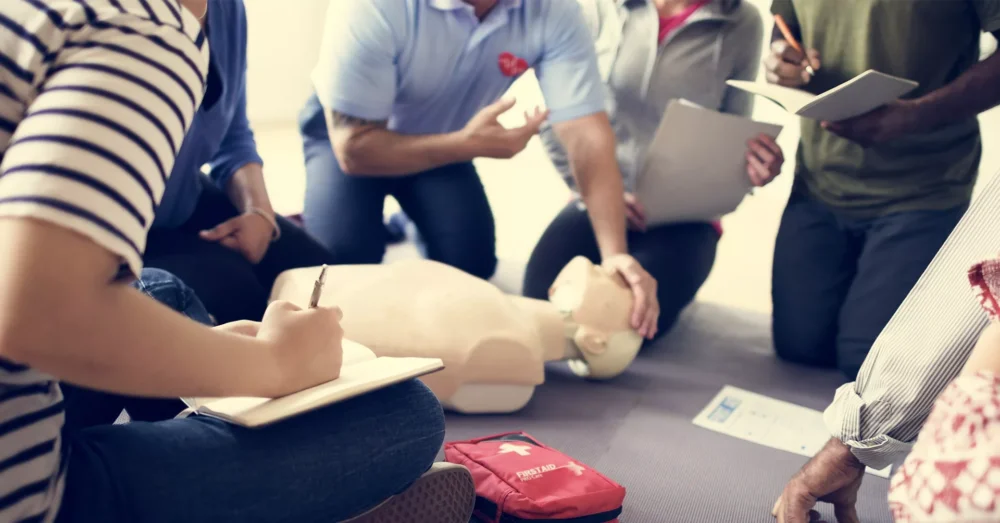First aid, a critical skill, serves as the immediate and temporary care given to any person suffering a sudden illness or injury. It’s the linchpin in emergency situations, providing an invaluable lifeline until professional help arrives. This topic is brimming with everyday relevance, with emergencies occurring unexpectedly, from minor accidents at home to more severe situations. The breadth and scope of first aid training can be an instrumental force in fostering resilient individuals, creating safer communities, and ultimately saving lives.
The Life-Saving Potential of First Aid
The significance of first aid is underscored by numerous real-life scenarios where it has been the dividing line between life and death. Instances of people choking in restaurants, children suffering from heat strokes in parks, and individuals involved in road accidents are common. In these situations, immediate and effective initial help becomes the beacon of hope.
The American Heart Association estimates that approximately 45% of out-of-hospital cardiac arrest victims survived when bystander CPR was administered. The life-saving potential of first aid is monumental; it enables trained individuals to be crucial interveners, administering immediate care and potentially altering the outcome of emergency situations.
Immediate Response to Injuries

Source: esafety.com
First aid training is pivotal in enabling a prompt response to various injuries, acting as the first line of defense in medical emergencies. From minor abrasions and burns to more severe conditions like fractures, the knowledge acquired through first aid training is essential. It allows individuals to address bleeding promptly, assess the severity of burns, and immobilize fractures, thereby preventing further harm.
Quick intervention in these common scenarios can be pivotal, reducing the risk of complications and promoting faster recovery. Being well-versed in initial help procedures can make a substantial difference in the immediate aftermath of an injury, providing support and care when it is most needed.
Confidence in Crisis
Beyond the practical applications, first aid training fosters a sense of confidence and composure during emergencies. Individuals armed with this knowledge can maintain their calm, assess situations accurately, and act decisively.
The anecdotes of bystanders stepping forward, devoid of panic, and performing life-saving maneuvers in times of crises are a testament to the empowering nature of initial help knowledge. This assurance doesn’t just benefit the individual; it creates a ripple effect, calming those around and creating an environment conducive to effective emergency response.
Reducing Severity of Injuries

Source: nytimes.com
The importance of immediate first aid extends to its capability to mitigate the severity of injuries. Proper techniques and timely intervention can prevent minor injuries from escalating into major health crises. For instance, correctly immobilizing a fracture can prevent further damage, and immediate cooling of burns can reduce the depth of the injury.
Such immediate care can be instrumental in minimizing damage, reducing recovery time, and preventing long-term consequences, showcasing the transformative impact of initial help in injury management.
The Chain of Survival
The chain of survival is a series of actions that, when performed in sequence, significantly increase the likelihood of survival in emergencies. It begins with recognizing the emergency and calling for help, followed by early CPR and defibrillation, and finally advanced life support and post-arrest care.
First aid is integral in this chain, particularly in the initial stages. It involves the immediate recognition of life-threatening situations and the initiation of life-saving interventions, creating a foundation for the subsequent links in the chain and improving the overall chances of survival.
Workplace Safety and Legal Requirements
The repercussions of first aid extend into the workplace, where safety is paramount. Employers and organizations benefit immensely from having first aid-trained personnel, ensuring a prompt response to any emergency. Many countries mandate the presence of trained first aiders in workplaces, acknowledging their role in maintaining a safe working environment.
The legal and ethical implications underscore the indispensability of initial help training in fostering workplace safety and compliance with regulatory standards.
Empowering Communities

Source: alertmedia.com
Widespread first aid training has the power to transform communities. When individuals are equipped with first aid knowledge, it builds a collective resilience, enabling communities to respond effectively to emergencies.
The narratives of communities implementing comprehensive initial help education and witnessing a decline in preventable deaths and injuries are powerful. They illustrate the potential of collective knowledge in shaping safer, more responsive environments, reinforcing the societal benefits of widespread first aid training.
Preparing for Natural Disasters
First aid training gains added relevance in regions susceptible to natural disasters. Whether facing hurricanes, earthquakes, or floods, the foundational knowledge of first aid becomes an invaluable resource. In the wake of such disasters, professional help may be delayed, making the role of individuals with initial help knowledge critical. They can administer immediate care, manage injuries, and offer support until more advanced help arrives, highlighting the profound impact of first aid skills in disaster response.
First Aid as a Life Skill
First aid stands out as a universally valuable life skill, transcending professional boundaries and becoming a beacon of hope in emergencies. It equips individuals with the knowledge and skills to be the first responders, irrespective of their occupation. The emphasis is on encouraging everyone, from students to professionals, to consider acquiring initial help training, understanding its transformative potential in saving lives and making a difference in emergency situations.
Accessibility of First Aid Training

Source: c2cfirstaidaquatics.com
The journey to acquiring first aid skills has become increasingly accessible, with various options available to suit different needs and schedules. Numerous organizations offer courses, both in-person and online, allowing individuals to gain knowledge at their convenience. The flexibility and variety of training programs ensure that initial help training is within reach for everyone, making it easier for individuals to arm themselves with this life-saving skill.
Taking Charge in Emergencies
First aid training is a catalyst for change, empowering individuals and communities to take charge in emergencies. It provides the skills and confidence needed to respond effectively to a range of situations, from minor injuries to life-threatening emergencies.
The amalgamation of practical skills, confidence, and knowledge garnered through first aid training makes it an invaluable asset in emergency management. It’s not merely a skillset; it’s a commitment to being a pivotal part of emergency response, a call to action for everyone to consider enrolling in an initial help course and embracing the potential to make a life-changing difference.
















